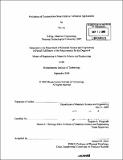| dc.contributor.advisor | Eugene A. Fitzgerald. | en_US |
| dc.contributor.author | An, Tao, M. Eng. Massachusetts Institute of Technology | en_US |
| dc.contributor.other | Massachusetts Institute of Technology. Dept. of Materials Science and Engineering. | en_US |
| dc.date.accessioned | 2009-04-29T17:29:59Z | |
| dc.date.available | 2009-04-29T17:29:59Z | |
| dc.date.copyright | 2008 | en_US |
| dc.date.issued | 2008 | en_US |
| dc.identifier.uri | http://hdl.handle.net/1721.1/45356 | |
| dc.description | Thesis (M. Eng.)--Massachusetts Institute of Technology, Dept. of Materials Science and Engineering, 2008. | en_US |
| dc.description | Includes bibliographical references (leaves 43-44). | en_US |
| dc.description.abstract | Solar energy has become a hot prospect for the future replacement of fossil fuels, which have limited reserves and cause environmental problems. Solar cell is such a device to directly generate electricity from this clean and renewable energy source. Today's photovoltaic market is dominated by Si flat-plate solar modules, but its production cost is still much higher than that of fossil-fuelled power plant. To reduce this cost, sunlight concentrator, which is made of cheap materials like glass, polymers and metals, can be used together with the solar cell. It is able to focus a wide column of sunrays onto a small piece of solar cell, thus the required dimension of the cell is greatly reduced. The cost analysis showed that it is preferable to use high-end solar cells with higher concentration ratio, since this leads to great increase in output power and less significant increment in overall cost, as this cell cost is small compared with the entire solar unit cost. The best concentration system with most efficient solar cell is found to be able to achieve a lower average price than Si flat-plates, and with sufficient market penetration, its average cost may even be comparable to that of a newly established coal-fired power plant. Therefore, concentration solar module has great potential to secure its share in the fast-growing photovoltaic market, serving as supplement to currently dominating fossil fuels and even replacement for them. Existing IP was also carefully reviewed to find out possible aspects for future developments. Finally, possible business strategies were studied and discussed. It was recommended to start as an IP company, which may expand to manufacturing company in the long run. | en_US |
| dc.description.statementofresponsibility | by Tao An. | en_US |
| dc.format.extent | 47 leaves | en_US |
| dc.language.iso | eng | en_US |
| dc.publisher | Massachusetts Institute of Technology | en_US |
| dc.rights | M.I.T. theses are protected by
copyright. They may be viewed from this source for any purpose, but
reproduction or distribution in any format is prohibited without written
permission. See provided URL for inquiries about permission. | en_US |
| dc.rights.uri | http://dspace.mit.edu/handle/1721.1/7582 | en_US |
| dc.subject | Materials Science and Engineering. | en_US |
| dc.title | Evaluation of concentration solar cells for terrestrial applications | en_US |
| dc.type | Thesis | en_US |
| dc.description.degree | M.Eng. | en_US |
| dc.contributor.department | Massachusetts Institute of Technology. Department of Materials Science and Engineering | |
| dc.identifier.oclc | 316802547 | en_US |
